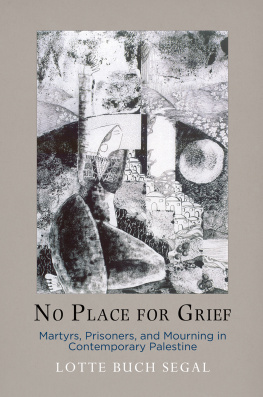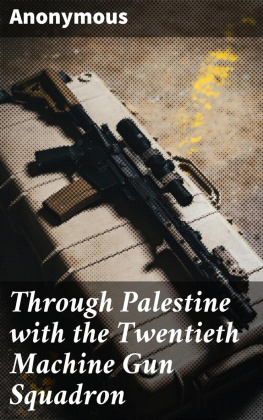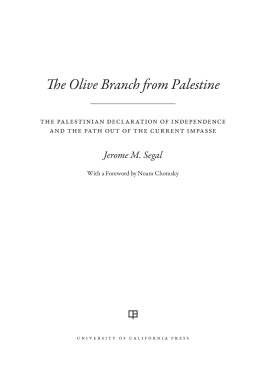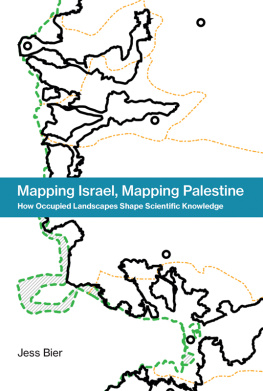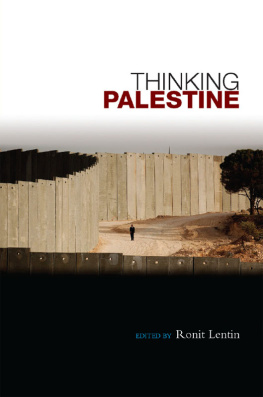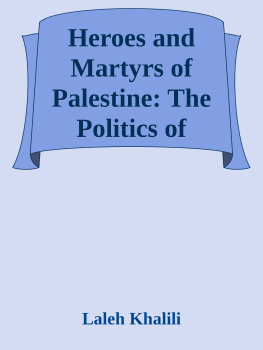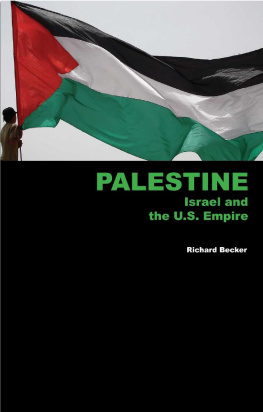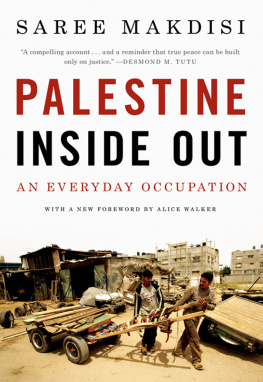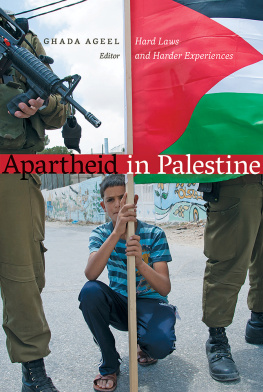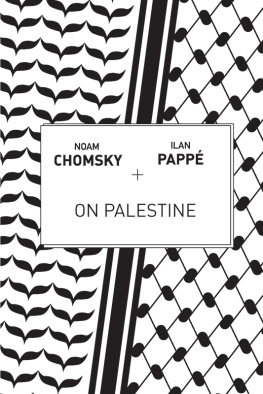Contents
Page List
Guide

No Place for Grief
THE ETHNOGRAPHY OF POLITICAL VIOLENCE
Tobias Kelly, Series Editor
A complete list of books in the series
is available from the publisher.
NO PLACE FOR GRIEF

Martyrs, Prisoners, and Mourning
in Contemporary Palestine
Lotte Buch Segal

UNIVERSITY OF PENNSYLVANIA PRESS
PHILADELPHIA
Copyright 2016 University of Pennsylvania Press
All rights reserved. Except for brief quotations used for purposes of review or scholarly citation, none of this book may be reproduced in any form by any means without written permission from the publisher.
Published by
University of Pennsylvania Press
Philadelphia, Pennsylvania 19104-4112
www.upenn.edu/pennpress
Printed in the United States of America on acid-free paper
1 3 5 7 9 10 8 6 4 2
A catalogue record for this book is available from the Library of Congress.
ISBN 978-0-8122-4821-0
For Sune, David, and Elias
CONTENTS

PREFACE

My time in Palestine has left me with a sadness that flows from the experiences of the people I encountered there. The question of whether this influences my interpretation of words, human beings, and situations is at best rhetorical. Many times I did not know how to respond to the words, tears, or gestures of the human beings at the heart of this book. How could I reply? As a female researcher from one of the most affluent societies of the world. As a woman whose life is not imperiled by the systematic exhaustion of the Palestinian occupation. As someone who feels empathy with the people she meets without certainty that empathy is ever exhaustive or necessarily the pathway to knowledge.
A student in my Psychology in Anthropology course asked me after having read of this book for class: Do you understand these women? To this question I replied with a qualified Yes. It is a yes only if we mean knowledge in the sense of acknowledgment, which I offer here. I have done my best not to simplify these womens experiences, but I also know that I could not entirely avoid it.
I feel compelled to act upon what I know, but I am not sure of the consequences. I write. I tell. Who listens? Some do. Does it matter? I do not know. Joo Biehl once asked me what I thought was the most powerful part of my work. It took me an hour to dare to say that it may have been sitting down and listening to those women, so at least they knew that I had heard their stories. They knew, and I knew. Now you know.
NOTE ON TRANSLITERATION

In transliterating Arabic words to English I follow Hans Wehr, A Dictionary of Modern Written Arabic: ArabicEnglish, edited by J. Milton Cowan (London: MacDonald and Evans, 1980). For smoother reading, the names of people have been transliterated without diacritical markings.
Introduction
I merged a little with the void
sitting in a nocturnal room and was filled
with your silence
that trembled in the picture
Ghada al-Shafii
Lumas husband was killed in an air raid near their house on the outskirts of a major Palestinian city. She heard the bombing and knew immediately that her husband was its most likely target.
Thirteen years have passed since his death. Luma has mourned him, and she could remarry without any social censure, as other widows have done. But she adamantly refuses. The first time we met she told me so, though not in so many words. She revealed her conviction in the slight upward tilt of the chin and click of the tongue that means no, of course not, among Palestinians.
Whenever she spoke of her husbands death, her voice would rise to a higher pitch and her face and cheeks would color. The adrenaline coursing through her body was evident. Talking about his death in its minutest details, Luma recounted how she went through stages of fear, anticipation, and an uncanny sense of knowing that her husband was dead, even before official confirmation. When she was finally certain that her husband had been killed, she descended into a state of desolation.
Luma spoke about his death in a way that conveyed the sorrow of losing a husband in culturally appropriate terms and emphasized her feelings for him. As the wife of a politically active man, she had to put her life on hold when her husband was detained in Israeli prisons, after he had fled and hid preceding his incarceration. Up to his death in 2002, their twelve-year relationship had oscillated between moments of happiness, like their wedding and the birth of their children, and moments of anxiety and hardship during his imprisonment. Luma told me how his first imprisonment occasioned nearly as much grief as his death ten years later. We may even surmise that her husbands death allowed Luma to reconnect with a certain normalcy, because, in her words, it was not until a year after her husbands death that life again, or perhaps for the first time, became normal.
When Luma finished her story, she dried her tears, rushed to her kitchen, and proudly brought back two kinds of homemade cake for us to have with our coffee. She said it had done her good to cry.
However, not all kinds of conjugal loss lend themselves so easily to a story of mourning and desire. Lumas lossthe possibilities and the limitations of how she could express itinstigated my study of the consequences of being in a population, and a kind of marriage, that tend to be cast by Palestinians and academics alike in a language of heroism, perseverance, and national solidarity. I wanted to consider what happens when the emotional remains of being a bereaved wife appear to outweigh the sense of belonging to a collective, and when life in the shadow of heroism is unable to find expression.
One woman, Yara, appears to encapsulate precisely this dilemma. Her husband has been detained since 2001, and Yara herself has also been imprisoned. Yet with seven hundred thousand Palestinians incarcerated in Israel since 1967 (Btselem 2015), the confinement of Yaras husband is nothing out of the ordinary. Imprisonment is lived, felt, and endured by the vast majority of families in occupied Palestine.
Yara lived next door to a Palestinian friend of mine in an upscale neighborhood of Ramallah. It was a rainy November day in 2007 when we first met. Gently ushering my assistant Rawan and me inside her living room, Yara seemed somewhat uneasy at the prospect of talking about her husbands confinement, of presuming that her own words mattered as much as her husbands. I explained that part of my project was to invite women to describe the experience of confinement for those left behind.
To a woman like Yara, the history of the Palestinian resistance movement and its varying intensities are woven into her account of her emotions about her husbands imprisonment. As she recounted the early phases of resistance, she remembered how, at that time, political men were highly respected among Palestinian people and society.
However, Yara also explained how doubt had slowly but persistently crept into her conviction that she and her husband should devote their lives to politics: I was thinking, Why are you leaving your house and your wife and your kids; who are you doing this for? No one cares anymore.

